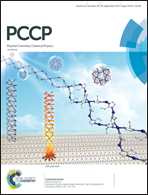Importance of the alignment of polar π conjugated molecules inside carbon nanotubes in determining second-order non-linear optical properties†
Abstract
We employed density functional theory (DFT) calculations with dispersion corrections to investigate energetically preferred alignments of certain p,p′-dimethylaminonitrostilbene (DANS) molecules inside an armchair (m,m) carbon nanotube (n × DANS@(m,m)), where the number of inner molecules (n) is no greater than 3. Here, three types of alignments of DANS are considered: a linear alignment in a parallel fashion and stacking alignments in parallel and antiparallel fashions. According to DFT calculations, a threshold tube diameter for containing DANS molecules in linear or stacking alignments was found to be approximately 1.0 nm. Nanotubes with diameters smaller than 1.0 nm result in the selective formation of linearly aligned DANS molecules due to strong confinement effects within the nanotubes. By contrast, larger diameter nanotubes allow DANS molecules to align in a stacking and linear fashion. The type of alignment adopted by the DANS molecules inside a nanotube is responsible for their second-order non-linear optical properties represented by their static hyperpolarizability (β0 values). In fact, we computed β0 values of DANS assemblies taken from optimized n × DANS@(m,m) structures, and their values were compared with those of a single DANS molecule. DFT calculations showed that β0 values of DANS molecules depend on their alignment, which decrease in the following order: linear alignment > parallel stacking alignment > antiparallel stacking alignment. In particular, a linear alignment has a β0 value more significant than that of the same number of isolated molecules. Therefore, the linear alignment of DANS molecules, which is only allowed inside smaller diameter nanotubes, can strongly enhance their second-order non-linear optical properties. Since the nanotube confinement determines the alignment of DANS molecules, a restricted nanospace can be utilized to control their second-order non-linear optical properties. These DFT findings can assist in the design of nanotube-based materials exhibiting stronger non-linear optical properties.



 Please wait while we load your content...
Please wait while we load your content...